Honey gourami, scientifically known as Trichogaster chuna, is a small, vibrant, and peaceful freshwater fish that can be a great addition to a community aquarium.
These visually appealing fish originate from India, Bangladesh, Nepal, and other parts of South Asia. Their attractive coloration, unique social behaviors, and ease of care make them especially popular among both novice and experienced aquarists.
In their natural habitat, honey gouramis are typically found in slow-moving or still waters with abundant aquatic plants. This environment provides them with ample hiding spots, foraging opportunities, and territorial boundaries that contribute to their overall well-being.
When setting up a home aquarium for honey gouramis, it is crucial to replicate their natural environment as much as possible. This includes providing appropriate tank requirements, diet and nutrition, and suitable tank mates.
Contents
Key Takeaways
- Honey gourami is a colorful and peaceful freshwater fish from South Asia
- Their natural environment includes slow-moving waters with abundant aquatic plants
- Proper care involves replicating their habitat, providing suitable diet, and choosing compatible tank mates
Check out these other fascinating fish for your aquarium:
Basic Characteristics
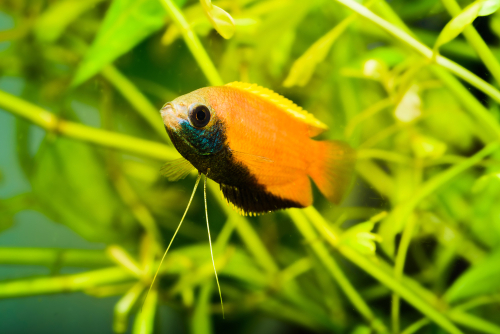
Life Cycle of a Honey Gourami
In captivity, a honey gourami can live for up to eight years. Both genetics and the standard of care they receive may have an effect on this. This range shows you how easily you can affect their life expectancy.
In the wild, they are unable to fend off predators and health issues for a variety of reasons. And lifespans are shortened as a result. It’s critical to measure the proper water parameters and keep them from being stressed in order to enhance the overall quality of life. These fish are incredibly resilient and tough, but it doesn’t make them unbeatable.
They do best in freshwater, with an accurate honey gourami temperature between 74 and 82°F. Within its species, the Honey Gourami is the shortest. Their largest dimensions are only 2.5 inches and, very sometimes, 3 inches. It takes them nearly two years to grow to their maximum size. Males and females differ in size by approximately an inch.
Appearance and Size
Honey Gourami (Trichogaster chuna) is a small, colorful fish that typically grows up to 2 inches in size. Their body shape is compressed, elongated, and somewhat oval. The fish is characterized by its distinct coloring, which varies among individuals.
Behavior and Temperament
In terms of behavior, Honey Gourami is a peaceful fish that coexists well with other non-aggressive species in a community aquarium. They tend to be shy and may feel comfortable hiding among plants, driftwood, or other decorations in the tank.
Despite their timid nature, Honey Gouramis display interesting behaviors such as inhabiting the middle and upper layers of the aquarium and engaging in surface feeding or air gulping.
Color Variations
Honey Gourami exhibits a range of color variations in its population. The most common colors are red, black, and blue. Some individuals may change color depending on their mood or environment, which adds to their visual appeal.
Their fins may exhibit different shades, as well, with some having more colorful or contrasting markings than others. This array of colors and patterns make them a popular choice among fish enthusiasts.
Natural Habitat
Geographical Origin
Honey Gourami (Trichogaster chuna), a small tropical fish species, is native to the freshwater regions of South Asia. More specifically, they can be found in countries such as Bangladesh, India, and Nepal.
It is important to understand their geographical origin as it directly impacts their ideal living conditions.
Natural Environment
In the wild, Honey Gourami thrive in slow-moving waters, often surrounded by dense vegetation. These locations provide the necessary protection as well as abundant food sources.
Their preferred habitats include lakes, rivers, and ponds. Exploring these natural environments, one could expect to find the following characteristics:
- Slow-moving water: Honey Gourami inhabit areas where the water flows calmly, allowing them to easily swim and navigate through the water.
- Lakes and rivers: These fish inhabit various bodies of water; aforementioned lakes and rivers are ideal for their needs.
- Vegetation: The presence of plants in their natural habitat not only provides the Honey Gourami with shelter, but also delivers a source of nutrition. Aquatic plants and algae are essential components of their diet primarily due to them being omnivorous.
Understanding the Honey Gourami’s natural habitat, specifically their geographical origin and natural environment, assists in creating a suitable living space for them in captivity, ensuring their long-term health and well-being.
Tank Requirements
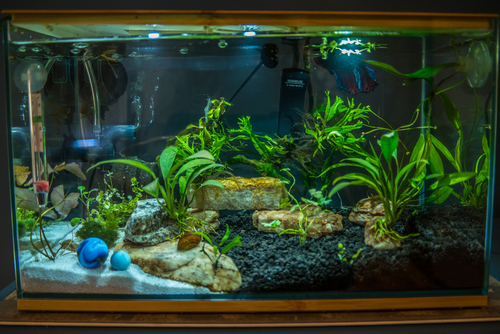
Tank Setup
Honey Gouramis are adaptable and thrive in a well-planned aquarium. To create a natural habitat, begin by adding live plants that provide cover and hiding spaces.
Floating plants, such as duckweed or fizzy, are great choices as they create shaded areas for the gouramis to rest. Along with plants, add rocks, driftwood, and other tank decorations that enhance the gourami’s sense of security and allow them to de-stress.
Tank Size
Honey Gouramis require adequate space to swim and explore. Thus, the minimum tank size recommended for them is 20 gallons. Providing a larger tank will result in a more comfortable and healthy environment.
| Tank Size | Number of Honey Gouramis |
| 20 gallons | 1-2 |
| 30 gallons | 3-4 |
Substrate and Lighting
Using a dark and fine-grained substrate is advised, as it not only mimics their natural habitat but also reflects lower amounts of light. Speaking of light, Honey Gouramis prefer low to moderate lighting conditions.
Excessive light can stress the fish and cause unfavorable conditions. Hence, it is best to use a dimmable light source or a low wattage bulb for the tank.
Temperature and Water Chemistry
Water parameters are critical in maintaining a healthy environment for Honey Gouramis. The recommended water temperature for these fish ranges between 72°F – 82°F (22°C – 28°C). A heater with an adjustable thermostat is essential to maintain a consistent water temperature.
| Water Parameter | Optimal Range |
| Temperature | 72°F – 82°F (22°C – 28°C) |
| pH | 6.0 – 7.5 |
| Hardness | 4 – 15 dGH |
To achieve suitable water chemistry, a pH between 6.0 – 7.5 and water hardness between 4 – 15 dGH is required. Careful monitoring and regular water changes are necessary to maintain optimal water parameters, ensuring the well-being of your Honey Gouramis.
Diet and Nutrition
Honey gouramis are omnivorous fish, which means they consume both plant and animal-based food sources. Their diet in the wild would naturally consist of small insects, larvae, and algae.
When kept in an aquarium, it is crucial to provide a varied and balanced diet to maintain their health and vibrant coloration.
A suitable diet for honey gouramis includes a mixture of high-quality flakes or pellets and live or frozen foods. Flakes and pellets specifically formulated for gouramis are rich in nutrients and provide a solid base for their daily diet.
However, they should be fed in moderation, as overfeeding can lead to obesity, digestive issues, and poor water quality. Live foods such as brine shrimp, daphnia, mosquito larvae, and bloodworms are excellent sources of protein for honey gouramis.
They also stimulate their natural hunting instincts, as the fish enjoy chasing and capturing their prey. Including live foods in their diet can contribute significantly to the well-being and overall health of these fish.
Frozen foods, such as brine shrimp, bloodworms, and daphnia, are good alternatives to live food. These options provide similar nutritional benefits, and some hobbyists prefer them due to the lowered risk of introducing parasites or diseases to the aquarium.
Algae plays a vital role in honey gouramis’ nutrition. They are natural grazers and will nibble on soft and filamentous algae in the tank throughout the day. Algae wafers and spirulina flakes can also be included in their diet as occasional supplements.
Breeding Honey Gourami

Breeding Conditions
To breed Honey Gourami, it is important to prepare a separate tank with a size of at least 10 gallons.
A darker environment is preferable, so keep the tank dimly lit and provide hiding spots using plants or soft leafy vegetation. The water temperature should be maintained between 77-82°F, with a pH level of 6.0 to 6.5.
A mature pair of Honey Gouramis should be introduced into the breeding tank. To identify the males and females, observe their body shape and color. Males will have a brighter color and a slender body, while females are rounder and duller in color.
Proper nutrition plays a crucial role in breeding, so both males and females should receive a high-quality diet of live and frozen foods.
Spawning and Fry Care
During spawning, the male will build a bubble nest at the water surface using plants and debris. After the nest is complete, the courtship will begin, as the male tries to coax the female to spawn.
The male will wrap himself around the female and she will release her eggs, which the male will fertilize and move to the bubble nest. The number of eggs produced can vary from 200 to 800.
As the eggs continue to develop in the bubble nest, the male will protect and maintain the nest. The female should be removed from the tank at this point to prevent her from eating the eggs or disturbing the nest.
After about 1-2 days, the eggs will hatch, and the fry (baby Honey Gouramis) will emerge.
The fry should be fed with infusoria for the first few days, after which they can be introduced to newly hatched brine shrimp or crushed flake food. Frequent water changes of around 20-25% are necessary to ensure good water quality for the fry to grow.
Within a month, the fry will begin to display colors similar to their parents and can be moved to a larger tank with a suitable community environment.
Health and Longevity
Honey gouramis can live a healthy life when provided with proper care and attention. These fish typically have a lifespan of 4 to 8 years. To ensure their health and longevity, a few factors should be considered.
Regular water changes are crucial for maintaining a clean and healthy environment for honey gouramis. It is recommended to change 20-30% of the water weekly. This practice helps to remove waste, improve the water quality, and prevent the buildup of harmful substances.
Filtration is another essential aspect of maintaining a healthy environment for honey gouramis. Suitable filtration systems help to remove debris, chemicals, and toxins from the water.
A well-functioning filtration system not only keeps the water clean but also provides proper water flow, which helps to supply oxygen to the gouramis’ gills.
Honey gouramis’ ventral fins are an important aspect of their health, as these fins help in navigating their environment. The fins should appear in good condition, with no signs of damage or deterioration.
Monitoring the ventral fins can help identify potential health concerns early on and take appropriate action.
Similarly, the gills are a vital part of a honey gourami’s respiratory health. They should appear as a deep red, signifying oxygen being exchanged properly with the water. Any discoloration or issues with the gills can be indicative of poor water quality, which may require immediate intervention.
Special Features
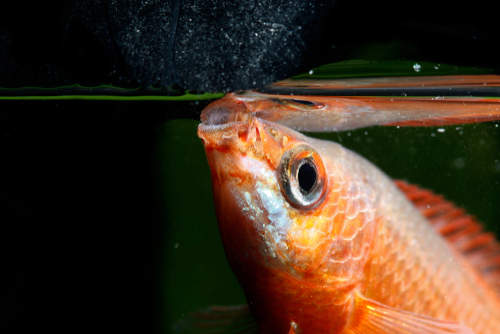
Labyrinth Organ
The honey gourami (Trichogaster chuna) possesses a unique anatomical structure known as the labyrinth organ. This specialized organ, located close to the gills, enables the fish to efficiently extract oxygen from the air.
The labyrinth organ consists of folded tissue with blood vessels, making it highly effective for gas exchange.
In its natural habitat, the honey gourami often encounters low-oxygen environments, such as stagnant ponds and swamps, which make the labyrinth organ crucial for its survival.
This characteristic enables honey gouramis to use atmospheric oxygen when their surroundings have depleted dissolved oxygen. The fish will rise to the water’s surface to gulp air, helping it survive in less-than-ideal conditions.
Bubble Nesting Behaviour
Another fascinating aspect of honey gouramis is their bubble nesting behavior. They are classified as “bubble nest builders,” which means that the males in the species create nests made up of air bubbles at the water’s surface.
During mating season, the male honey gourami will exhibit the following:
- Bubble Production: He will produce and release air bubbles coated in a special saliva, causing them to stick together and form the nest.
- Nest Defense: Throughout the construction process, the male will diligently guard his nest to ensure its safety and preparation for the female’s eggs.
- Courtship Display: To attract a female, the male will darken his colors, flare his dorsal and anal fins, and perform a dance.
- Egg Protection: Once the female joins him and lays eggs, the male will use his mouth to transfer the fertilized eggs to the bubble nest.
The male honey gourami parental instincts don’t end after placing the eggs in the bubble nest; he also protects them vigilantly until they hatch. After hatching, the fry are expected to fend for themselves, using the bubble nest for temporary shelter.
In both their labyrinth organ and bubble nesting behavior, the honey gourami showcases a unique set of characteristics that set them apart in the world of aquatics.
These features, along with their beautiful coloration and peaceful nature, contribute to their popularity in the aquarium hobby.
Choosing Tank Mates
When selecting tank mates for your honey gourami, it is important to consider their compatibility with other freshwater fish. Honey gouramis are generally peaceful fish, making them suitable for community aquariums with similarly tempered tank mates.
Tetras and rasboras are excellent choices for honey gourami tank companions. These small, schooling fish have peaceful dispositions and can coexist harmoniously with honey gouramis.
Additionally, corydoras and loaches make great bottom-dwelling tank mates, as they help keep the aquarium clean without bothering the gouramis.
It is best to avoid housing honey gouramis with aggressive fish, such as barbs and some larger species of cichlids. These fish may become territorial and cause stress or harm to the more peaceful gouramis.
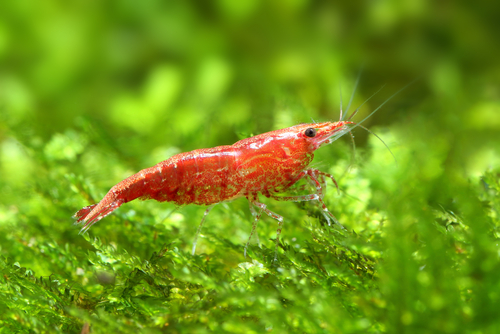
Also, keep in mind that honey gouramis should not be kept with dwarf gouramis, as they are prone to aggression towards each other. For those who favor invertebrates, shrimp and snails are excellent options as tank mates for honey gouramis.
These peaceful creatures contribute to a healthy aquarium environment by cleaning algae and detritus, without posing any threat to the gouramis. It is important to note, however, that honey gouramis may feed on small shrimp or their offspring.
When considering tank mates for your honey gouramis, it is crucial to provide enough space and hiding spots for both the gouramis and their companion species.
A well-planted aquarium with plenty of aquatic plants and decor can help achieve a harmonious environment for all inhabitants.
Lastly, make sure to take into account the dietary needs of your aquarium’s inhabitants. Honey gouramis are considered omnivores, and they thrive on a diet that consists of a mix of flake foods, live or frozen insects, and algae.
Keeping your honey gouramis well-fed can reduce the risk of them preying on their tank mates.
Varieties of Honey Gourami
Red Honey Gourami
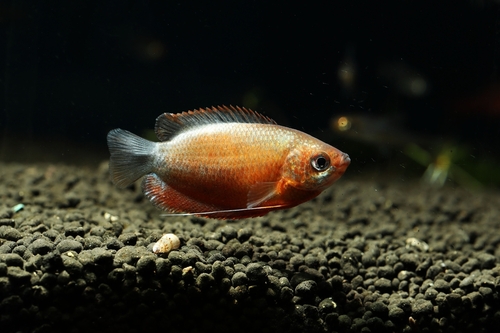
The Red Honey Gourami (Trichogaster chuna) is a popular variety of honey gourami, boasting a vibrant red-orange color.
They originate from India and Bangladesh, where they inhabit slow-moving water bodies such as ponds and swamps. Males are more brightly colored, particularly during breeding, while females are typically paler and smaller.
Their peaceful temperament makes them a perfect addition to community aquariums. It’s essential to provide plenty of aquatic plants and hiding spots to create a comfortable environment. A balanced diet, including both dry and live foods, promotes optimal health for Red Honey Gouramis.
Sunset Honey Gourami
Sunset Honey Gouramis, also known as the Orange Honey Gourami, display an array of colors from red to orange and yellow, resembling a sunset. They share similarities with the Red Honey Gourami in terms of habitat and temperament.
Sunset Honey Gouramis thrive in well-maintained aquariums with water parameters and temperatures mimicking their natural environment.
As omnivores, they require varied diets consisting of live, frozen, and flake foods for proper nutrition. When stressed or breeding, Sunset Honey Gouramis may darken in color.
Red Flame Gourami
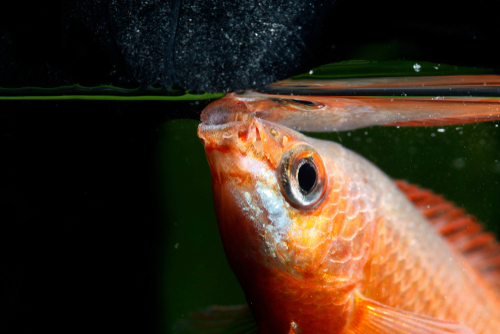
The Red Flame Gourami, another variety of honey gourami, is characterized by its striking red coloration with blue stripes. This hybrid is the result of breeding the Red Honey Gourami with the Blue Gourami (Trichogaster trichopterus).
Its natural habitat encompasses shallow, slow-moving waters filled with vegetation.
Red Flame Gouramis are relatively easy to care for, requiring stable water conditions and a well-balanced diet. They can be housed in peaceful community tanks, as they are compatible with a variety of tank mates.
However, avoid housing them with aggressive fish, as it can cause stress and disrupt their well-being.
Dwarf Gourami
It is also called Trichogaster lalius and is a common species of gourami fish. It is calm and smaller by nature. Because its center usually has a vivid red color, it is also known as the flaming gourami. Hybrids come in a variety of colors, though.
It is also thought of as a labyrinth fish since it uses a unique organ to breathe in air in order to obtain oxygen. It must be able to reach the water’s surface in order to do this. It does not grow much larger than two inches, even as an adult.
Its lifespan is often limited to four years, similar to that of many aquarium fish. Taking care of a dwarf gourami is quite simple.
Kissing Gourami

This particular gourami is interesting due to how its mouth is shaped, which gives it the name that “kissing gourami.” It is widely believed that these species act aggressively toward other smaller fish. Their size and violent nature may make them inappropriate tank mates for a typical gourami. As such, they should be kept among competitive tank mates.
This gourami species is on the larger side. It grows up to 12 to 13 inches and can live up to about 20 years. However, it will mostly need the skills of a seasoned aquarist to properly maintain them and keep them in good shape. But they will make an exciting and beautiful addition to your aquarium if you can take care of them.
Frequently Asked Questions
What is the lifespan of a Honey Gourami?
The lifespan of a Honey Gourami typically ranges between 4 to 8 years. However, their lifespan can vary depending on various factors, such as the quality of care, tank environment, and diet provided to them.
Regular water changes and a balanced diet can help ensure a longer life for these fish.
What is the ideal temperature for Honey Gouramis?
The ideal temperature for Honey Gouramis is between 72°F and 82°F (22°C and 28°C). It is crucial to maintain a stable temperature in the aquarium, as fluctuations can cause stress for these fish.
Additionally, it is recommended to use a heater and a thermometer to ensure the temperature remains consistent.
Do Honey Gouramis need to be kept in pairs?
Honey Gouramis are not schooling fish, but they do benefit from being kept in pairs or small groups. It is recommended to keep one male with several females, as multiple males in the same tank may lead to territorial behavior and aggression.
Providing enough hiding places in the aquarium can also help reduce stress in a community tank.
What is the average size of a Honey Gourami?
The average size of a Honey Gourami is approximately 2 to 3 inches (5 to 7.5 cm) in length. Males tend to be smaller and more slender than females, while female Honey Gouramis usually have a plumper appearance.
Both males and females have a distinct labyrinth organ, which allows them to breathe air from the surface of the water.
How many Honey Gouramis should be kept together?
The ideal number of Honey Gouramis to keep together depends on the space and tank setup, but generally, it is recommended to keep at least one male with two or more females in a 20-gallon tank.
If a larger community tank is available, the number of Honey Gouramis can be increased accordingly, but it is important to ensure that sufficient space and hiding spots are provided.
What is the difference between Sunset Gourami and Honey Gourami?
Sunset Gourami and Honey Gourami are both color variations of the same species, Trichogaster chuna. The distinct difference between the two lies in their coloration.
Sunset Gouramis have a vibrant reddish-orange hue with a darker stripe across their bodies, while Honey Gouramis have a golden-yellow appearance with a faint black stripe. The care and tank requirements for both color variations remain the same.

Veteran fish keeper and keen hobbyist with a serious case of MTS. My midlife crisis was the establishment of a fish room, much to my wife’s horror. Little does she know it could be worse!!


